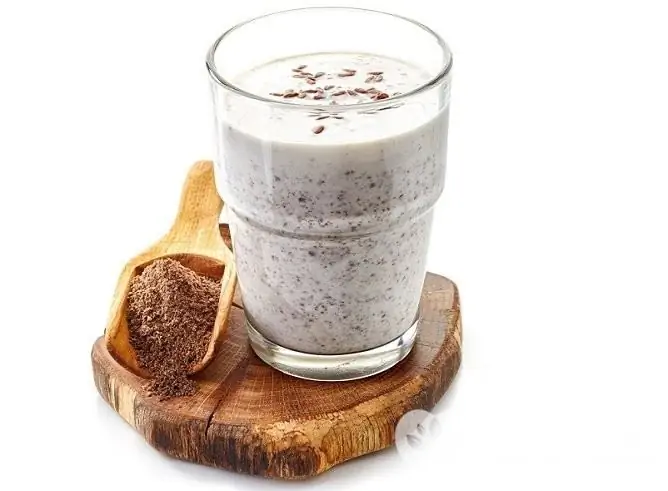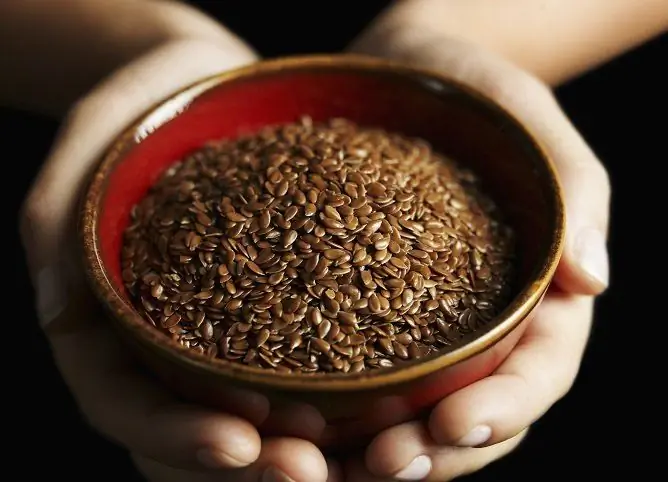- Author Rachel Wainwright [email protected].
- Public 2023-12-15 07:39.
- Last modified 2025-11-02 20:14.
Flax seed for constipation
The content of the article:
- Flaxseed properties
- How to take flaxseed medicinally for constipation
- Recommendations
- Contraindications and side effects
- Overview of constipation
- Video
Means based on flax seeds for constipation can be used not only for treatment, but also for prevention in case of a tendency to constipation.

Flaxseed is recommended to be purchased whole, and if you need to grind it, then do it immediately before use.
Despite the fact that folk laxatives are considered safe, they are not completely such, like any other medicine, they have contraindications. Therefore, before using traditional medicine, you must make sure that they are absent by consulting your doctor.
Flaxseed properties
Folk remedies are often used to treat constipation, and although the effects of herbal remedies are usually less pronounced than synthetic remedies, they are effective enough to help with a one-time or occasional problem. Flax seeds are among the safest and most mild-acting laxatives. Product properties:
- It is a natural sorbent, helps to eliminate toxins from the body.
- The composition contains a large amount of fiber, which contributes to the delivery of fluid to the large intestine, softening and excretion of feces from the body.
- When it enters the gastrointestinal tract, it secretes mucus, which envelops the intestinal wall, protecting it from injury by compacted feces.
- Once inside, it quickly swells, increasing the volume of stool and activating intestinal motility.
- Improves the absorption of nutrients.
- Has a minimum of contraindications.
According to reviews, flaxseed-based products are generally well tolerated by patients.
How to take flaxseed medicinally for constipation
If you have difficulty defecating, you can use medicines from flax seeds, made according to the following recipes:
| Name | Recipe / Features | How to use |
| Infusion | To prepare, take 1 tablespoon of raw materials, brew with 2 cups of boiling water, leave in a thermos for 8 hours and strain. | Adult patients drink 100 ml of infusion 3 times a day before meals, children over 7 years old - 50 ml 5 times a day. |
| Decoction | It helps well even with severe constipation. 1 tablespoon of raw materials is poured into 1 liter of boiling water, boiled over low heat under a lid for 1 hour, stirring occasionally. The broth is removed from the heat, allowed to cool and filtered. |
For adults, 1 glass 4 times a day, for a child 7 years and older, 0.5 glasses 4 times a day. |
| Seeds in pure form | No cooking required. The remedy is good for cases of motility disorders and / or mild constipation, in which there is an incomplete bowel movement. | Eat in the morning on an empty stomach, chewing well, 1 tablespoon (adults) or 1 teaspoon (children 2 years and older) seeds. Flaxseed should not be given to children under 2 years of age. |
| Seeds with kefir | Add 1 teaspoon of crushed (for example, ground in a coffee grinder) flax seeds to a glass of kefir. For children, 0.5 teaspoon of raw materials is dissolved in 1 glass of kefir. The tool helps well with delayed bowel movements in elderly people. | Drink in the morning on an empty stomach. |
| Infusion from a mixture of medicinal plants |
Prepared from equal parts of flaxseed, chamomile, thyme, tansy, bearberry, coriander. Two tablespoons of the resulting mixture are poured into 400-500 ml of boiling water, allowed to cool, filtered. |
Take 1/3 cup per day. The course of treatment with infusion is usually about 1 month. |
Recommendations
In order for flaxseed products to bring only benefits, you need to prepare and apply them correctly:
- Purchase seeds whole and grind them yourself, immediately before use. Ground flax can only be purchased in a vacuum package, otherwise the product will quickly lose its beneficial properties.
- The crushed raw materials must be washed down with a sufficient amount of water, which is necessary for its swelling, otherwise the effectiveness of the product is significantly reduced.
- Flax seeds can be added to fermented milk products (kefir, yogurt, yogurt), as well as to first courses, buckwheat porridge, oatmeal, corn grits.
- Flaxseed infusion (jelly) can be sweetened with honey.

Flax seeds are often consumed, filled with kefir - a tasty and healthy dietary drink is obtained
Contraindications and side effects
Flax-based products are not recommended for use during pregnancy, since their effect on the fetus has not been studied enough.
Contraindications to the use of the product are:
- individual intolerance;
- colitis;
- pancreatitis;
- cholecystitis;
- cholelithiasis;
- stones in the bladder;
- tendency to flatulence;
- polycystic ovary disease;
- endometritis;
- myoma;
- neoplasms;
- adhesive process in the gastrointestinal tract.
If you consume too much flaxseed or flaxseed preparations, the patient may develop diarrhea instead of constipation.
Flax should not be used to treat long-term bowel movements.
Overview of constipation
Constipation is a condition in which bowel movements occur less than three times a week. In a person, in addition to a long absence of defecation, there is a deterioration in general well-being, headaches, and abdominal discomfort. When there is a bowel movement, there is a compaction of feces, the release of fragmented feces. Often, the feces are scanty, after a bowel movement there is a feeling of incomplete emptying. The condition is often accompanied by hemorrhoids.
Pathology can develop in patients of all ages; with age, the risk of developing a pathological condition increases. Often this problem is observed in pregnant women. Constipation can occur against the background of organic or functional pathologies of the digestive tract, helminthic invasions, the presence of neoplasms in the body. In the absence of any diseases, the cause of its development is an unbalanced diet, a sedentary lifestyle, dehydration, stress (for example, a change in the environment), and often there is a combination of these factors.
In many cases, the solution to the problem is a change in lifestyle - correction of nutrition, maintaining an active, active lifestyle, and an adequate drinking regime. Medicines, physiotherapy exercises, massage can also be used for treatment.
Video
We offer for viewing a video on the topic of the article.

Anna Aksenova Medical journalist About the author
Education: 2004-2007 "First Kiev Medical College" specialty "Laboratory Diagnostics".
Found a mistake in the text? Select it and press Ctrl + Enter.






